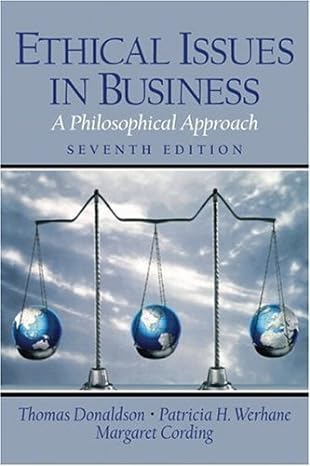Question
Richard was a computer engineer working for a payroll outsourcing company. His professional knowledge led him to believe that a small-cap firm specializing in developing
Richard was a computer engineer working for a payroll outsourcing company. His professional knowledge led him to believe that a small-cap firm specializing in developing new AI technology for warehousing had great potential. Richard withdrew all his savings of $38,000 and opened a margin account with a local brokerage company. The initial and maintenance margin requirements for that account were 50% and 30% respectively, and the call-money interest rate for the margin loan was 9%. Richard decided to maximize his purchase of the small firms stocks, which was trading around $7 per share: he entered a GTC limit order to buy 11,000 shares at $6.90 per share. A few days later, his limit-buy order was executed; Richard then immediately entered a GTC limit-sell order to sell all the shares at $7.95 and expected to earn 30% return on investment.
During the following 8 months, the stocks prices gradually dropped to $5.10. The company was scheduled to make its quarterly earnings announcement and Richard nervously waited for the results. Unfortunately, the earnings announcement, which was made after the market closed, was a bad one; the next morning, the stock had a huge gapping-down open price of $3.95. A few minutes after the market opened, Richard received a margin call from the brokerage firm. He did not have extra money to meet the call; thus, the brokerage firm made a forced-sale of a sufficient number of shares in order to remove the margin call. The sell
ing price for the forced-sale was $3.89 per share. Later that day, the stocks price rebounded a little to close at $4.08. Richards ex-fiance Sally had also followed the stock closely. She had had a big fight with Richard three weeks earlier and decided to breakup with him. The fight was about their planned wedding needing to be postponed indefinitely due to Richards savings being tied up in stock. Sally told Richard that he should have applied the stop-loss and gotten out of that stock long time ago. After the break-up, Sally also opened a margin account with all her savings of $9,000. She was waiting for the right time to sell-short the stock with the intention to prove Richard wrong. On the day Richard got the margin call, Sally was influenced by the companys bad earning news and decided to sell short 4,500 shares at a limit price of $4 per share. Her short-sale limit order was executed about 30 minutes before the market closed on that day.
In the following three months, the stock price fluctuated in a relatively wide range between $4.06 and $4.63. It was time for another quarterly earnings announcement. This time it was a very good news: 30% above the average of lower earnings estimates adjusted by the financial analysts since the last earnings season. Since the company had been plowing back all its earnings for growth, its stocks had never paid cash dividends in the past and would not pay the dividends in the near future. The stock responded to the good earnings news and jumped to $4.96 at the open the next day, then fluctuated between $4.70 and $5.46 over the next two months Afterward, the stock prices started to move up. Seven months later, the stocks price reached a new high of $8.00. Around that time, Richards limit-sell price of $7.95 was reached and all his shares were sold at that price. As for Sallys short position, she had covered all 4,500 short shares long ago when she received a margin call.
Answer the following questions.
1. If Sally covered all the short shares at the margin call price, what would be her holding-period rate of return (HPR)?
Step by Step Solution
There are 3 Steps involved in it
Step: 1

Get Instant Access to Expert-Tailored Solutions
See step-by-step solutions with expert insights and AI powered tools for academic success
Step: 2

Step: 3

Ace Your Homework with AI
Get the answers you need in no time with our AI-driven, step-by-step assistance
Get Started


